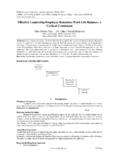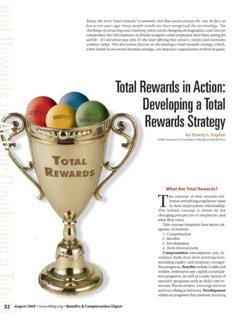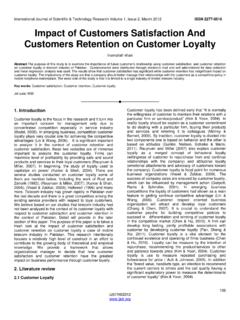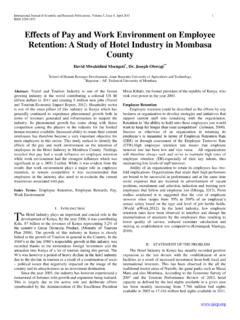Transcription of Looking at the bank from the customer's point of …
1 REPORT. Looking at the bank from the customer 's point of view October 2014. Looking at the bank from the customer 's point of view Contents Executive The drivers behind customer A brand new customer Dealing with customer Advice for advocacy; a win-win About 2. Executive summary During the summer of 2014, EY was asked to contribute to four think tanks organised by Efma, the European association for retail financial services. The think tanks explored the theme Looking at the bank from the customer 's point of view.
2 Discussions were framed around the results of EY's third annual Global Consumer Banking Survey: Winning through customer experience, which launched in spring 2014. The survey canvassed the views of more than 32,500 retail banking customers in 43 countries This paper summarises the key areas of discussion, including contributions and insight from Efma members who participated in the think tanks. Each event examined a particular aspect of customer service in retail banking. Some of the key points were as follows: E.
3 Uropean banks' customers are increasingly willing to switch. This is making long-term customer relationships more valuable. In response, banks are strengthening their acquisition and retention efforts. Transparency, simplicity and effective communication are particular areas of focus. C. ustomer interactions with their banks are moving from a physical to remote-channel framework, and are increasingly split between self-served and intermediated. Personalised, human-based contact is still preferred for complex needs, but openness to remote counselling is growing.
4 This requires banks to move from a silo multi-channel approach to an omni- channel model, supported by effective segmentation, to deliver a customer -centric experience. C. ustomer complaints are growing in number and reputational importance. They also represent a golden opportunity to build stronger relationships. Banks are trying to improve their response, but face many structural obstacles. Transparency, employee empowerment and data analysis play a key role. E. ffective advice is a key driver of satisfaction, trust and advocacy.
5 Though many customers prefer personal advice, there is scope to do more remotely. But this requires a difficult mix of technology and expertise. Regulation is also a hurdle. For banks that can use it to their advantage, social media has the potential to enhance levels of engagement with customers. Reconciling these competing forces to achieve success will not be easy. There will be significant implications for banks' business models. The overall strategic imperatives are to strengthen customer attraction and retention.
6 Making the required improvements will depend on developing a range of capabilities and overcoming a variety of obstacles. These will depend on each bank 's current business models and competitive positioning. We hope readers will find this paper a useful and interesting starting point to explore some of the complex customer challenges facing European banks. We would be delighted to hear your views. Marco Brandirali Gianluca Ghigliano Director Senior Consultant FSO Advisory, EY Italy FSO Advisory, EY Italy + 39 02 8066 9693 + 39 02 722 121.
7 1. Visit to download a copy of EY's Global Consumer Banking Survey 2014. 3. Looking at the bank from the customer 's point of view The drivers behind customer choice Retail banking customers in Europe continue to become less loyal and more nomadic. Our survey shows that they are increasingly willing to challenge existing financial relationships and look for alternatives. This means that long-term customer relationships are going to become less common than in the past, but more essential to banks' profitability.
8 In fact, growing acquisition costs mean that few customer relationships make a profit during their first two years. Instead, profitability strengthens over time as customers purchase more products and services, contact the bank less often and via less costly channels, and generate more referrals. It is more important than ever for European banks to understand the drivers of customer attraction and retention. Our survey shows that three factors drive customer choice of new bank accounts: 1. Anticipated customer experience 2.
9 The level of rates or fees 3. Convenience In Eastern Europe, accessibility and branch location are also important factors. Once they have joined a bank , customers' strongest drivers of satisfaction are accessibility and transparency. And when it comes to closing bank accounts, the leading factors are dissatisfaction with rates and fees, or a disappointing customer experience. This means that customers appear to leave banks over cost issues, but are more likely to choose new ones based on the promised customer experience.
10 This pattern is especially common in markets such as Italy, Spain and Turkey. By contrast, customers in the UK are more likely to close a bank account based on their experience, and to open a new one based on attractive rates or fees. The drivers behind customers' choice Reasons for opening and closing accounts Western Eastern United Global Europe Europe France Germany Italy Spain Kingdom Russia Turkey Experience with financial 33% 25% 30% 25% 27% 34% 25% 35% 31% 37%. services providers 41% 36% 38% 39% 31% 39% 36% 25% 33% 42%.

















